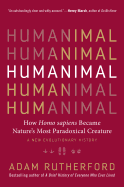
All living creatures--bedbugs and bonobos, yeast and yellowjackets, hedgehogs and humans--have much in common. We all descend from a single point of origin, share DNA and evolve through natural selection. But about 40,000 years ago, humans took a "Great Leap Forward" and achieved a level of sophistication not found in other animals. Humans are special, but are we unique?
In Humanimal, science writer Adam Rutherford (A Brief History of Everyone Who Ever Lived) considers the behaviors that Homo sapiens share with animals, and those that are different, to help us understand our own evolution. For example, many animals use tools, such as the firehawk, which picks smoldering sticks from brush fires to create new fires and feast on escaping creatures. Yet no other animal has the brain capacity or dexterity to create tools like humans. While it's a given that humans have sex for pleasure and procreation, Rutherford is reluctant to affix human sexual emotions onto animals. But many species also engage in sexual activity without the intent to procreate. Homosexuality is also prevalent in the animal kingdom, as are sexual behaviors like masturbation and fellatio, behaviors we often ascribe only to humans.
So, what makes humans distinct? Many animals communicate and share the ancient gene FOXP2, but only in humans did the right combination of FOXP2 and other genes yield speech. Rutherford theorizes that the human population explosion during the Great Leap Forward allowed for the transmission of skills. While many animals are capable of learning, it's only humans who teach, leading to the development of culture that sets us apart. --Frank Brasile, librarian

